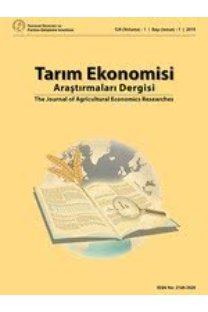Döviz Kurundaki Değişimin OECD Tarımsal Destek Göstergeleri ile İlişkisi: Türkiye Örneği
tarımsal destek, üretici destek tahmini, döviz kuru, Türkiye
The Relationship Between the Change of Exchange Rates and OECD’s Producer Support Estimates: The Case of Turkey
agricultural support, producer support estimate, exchange rates, Turkey,
___
- Blandford, D., Brunstad, R.J., Gaasland, I., Vardal, E., 2007. Optimal agricultural policy and PSE measurement: an assessment and application to Norway. NHH Dept. of Economics Discussion Paper.
- Cheng, F., Orden, D., 2007. Exchange rate alignment and producer support estimates (PSEs) for India." Agricultural Economics 36:233-243.
- Comtrade, 2020. UN Comtrade Database. https://comtrade.un.org/, Erişim Tarihi: 06.10.2020
- Demirdöğen, A., 2011. Tarımsal Korumacılık, Korumacılığın Ölçümü ve Türkiye. Yüksek Lisans Tezi, Fen Bilimleri Enstitüsü, Çukurova Üniversitesi.
- Demirdöğen, A., 2020. Türkiye’de Tarımsal Destekler. 5. Uluslararası Anadolu Tarım, Gıda, Çevre ve Biyoloji Kongresi.
- Doyon, M., Paillat, N., Gouin, D., 2001. Critical Analysis of the Concept of the Producer Subsidy Equivalent in the Dairy Sector (Dairy PSE). GREPA Group de Recherche en économie et poliques agricoles.
- HMB, 2020. Merkezi Yönetim Bütçe İstatistikleri. T.C. Hazine ve Maliye Bakanlığı.
- Liefert, W.M., Sedik, D.J., Koopman, R.B., Serova, E., Melyukhina, O., 1996. Producer Subsidy Equivalents for Russian Agriculture: Estimation and Interpretation. American Journal of Agricultural Economics 78:792-798.
- OECD, 2016. OECD’S Producer Support Estimate and Related Indicators of Agricultural Support: Concepts, Calculations, Interpretation and Use (The PSE Manual). OECD Publishing.
- OECD, 2020a. Producer and Consumer Support Estimates database. http://www.oecd.org/agriculture/agricultural-policies/producerandconsumersupportestimatesdatabase.htm, Erişim Tarihi: 15.06.2020
- OECD, 2020b. Exchange rates (indicator). https://data.oecd.org/conversion/exchange-rates.htm, Erişim Tarihi: 06.10.2020
- Oskam, A.J. ve Meester, G., 2006. How useful is the PSE in determining agricultural support?. Food Policy 31:123-141.
- Tangermann, S., 2005. Is the Concept of the Producer Support Estimate in Need of Revision?, OECD Publishing.
- Tangermann, S., 2006. Response to the article on “How useful is the PSE in determining agricultural support? by Arie Oskam and Gerrit Meester. Food Policy 31:142-147.
- TCMB, 2020. Elektronik Veri Dağıtım Sistemi. https://evds2.tcmb.gov.tr/, Erişim Tarihi: 07.10.2020
- TOB, 2020. Tarımsal Destekler. https://www.tarimorman.gov.tr/Konular/Tarimsal-Destekler, Erişim Tarihi: 07.10.2020
- Wise, T.A., 2004. "The paradox of agricultural subsidies: measurement issues, agricultural dumping, and policy reform. Tufts University, Working Papers.
- Yayın Aralığı: Yılda 2 Sayı
- Başlangıç: 2015
- Yayıncı: Tarımsal Ekonomi ve Politika Geliştirme Enstitüsü Müdürlüğü
Riskin Kuru Kayısı Üreten İşletmelerin Performansına Etkisi
Türkiye’nin Kenevir Politikası ve Piyasasına Bir Bakış
Zehra ÇİÇEKGİL, Yener ATASEVEN
Döviz Kurundaki Değişimin OECD Tarımsal Destek Göstergeleri ile İlişkisi: Türkiye Örneği
Edamisan Stephen IKUEMONISAN, Taiwo Ejiola MAFIMISEBI, Igbekele AJIBEFUN, Kemisola ADENEGAN
